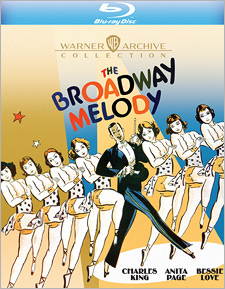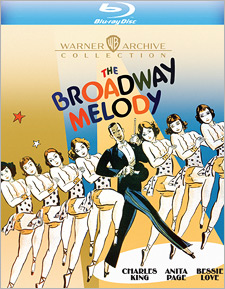Broadway Melody, The (1929) (Blu-ray Review)

Director
Harry BeaumontRelease Date(s)
1929 (July 25, 2023)Studio(s)
Metro-Goldwyn-Mayer (Warner Archive Collection)- Film/Program Grade: C
- Video Grade: A
- Audio Grade: A-
- Extras Grade: B-
Review
The Broadway Melody is one of the first Best Picture Academy Award winners and established a template for many backstage musicals to follow. Touted as “100% All Talking! 100% All Singing! 100% All Dancing!,” the film focuses on two young women whose sister act is a success on the road and now are trying to make it in the Big Apple.
Queenie and Hank Mahoney (Anita Page, Bessie Love) have reached the peak of success in vaudeville and are hungry for greater acclaim at the pinnacle of show business—Broadway. They soon discover that getting into a show on the Great White Way isn’t easy. Competition is formidable and they will need to persevere. Hank is a fighter with confidence to spare. Queenie, the younger sister, is statuesque and beautiful but hesitant and vulnerable. Hank has always been protective of Queenie.
Hank’s fiancé, Eddie Kearns (Charles King), is a singer for a Ziegfeld-style producer and manages to get the sisters roles in a major production. Things become romantically complicated when Eddie realizes he prefers the flashy Queenie to the more understated Hank and the feeling turns out to be mutual. To avoid hurting Hank, Queenie accepts the advances of smooth stage-door-Johnny Jacques Warriner (Kenneth Thomson).
As the dramatic machinations unfold, musical numbers pop up to pump some life into the dreary plot. The most famous of these is the title number and it’s the only song heard during the first 40 minutes of the film, performed and endlessly reprised. Other notable tunes are the love song You Were Meant for Me, sung by Eddie to Hank, and songs in the revue-style stage show, including The Wedding of the Painted Doll, an elaborate production number, Truthful Parson Brown performed by The Biltmore Trio with guitar and ukulele accompaniment, and Love Boat, a glittery extravaganza. The settings of the songs vary. Some are performed in rehearsal, others in performance, to make them blend easily into the narrative. You Were Meant for Me is somewhat jarring, as a dialogue scene switches with minimal transition to Eddie’s song. In later musicals, gentle underscoring would accompany dialogue leading up to the song.
Both Love and Page do a good job as sisters who find themselves in love with the same man. They deliver their dialogue believably. Page, as the younger, more glamorous sister, conveys a degree of innocence that renders Queenie’s determination to become a rich playboy’s mistress in order to protect her sister a touching act of self-sacrifice. As Hank, Love conveys veteran show biz toughness and sisterly concern for Queenie’s welfare. She received a Best Actress nomination. King, on the other hand, is stiff and unconvincing as Eddie, both in on-stage and in personal scenes. It’s hard to accept him as the romantic focus of two attractive young women. Thomson’s Jacques is the kind of character that inspires hissing. Suave to the point of unctuousness, he’s the wolf preying on the pretty young ingenue. With his slicked back shoe-polish hair and overall creepiness, Jacques is the embodiment of the man mothers warn their daughters against.
Director Harry Beaumont has done his best to bring Edmund Goulding’s screenplay to life, but his major problem is pacing. The film is too long by at least fifteen minutes, and momentum never builds. The scenes seem slotted in rather than smoothly flowing, one into the next. Old-fashioned silent inter-titles bridge scenes and establish locations. Camera work is dull, with the musical numbers filmed mostly in long shot, as if the viewer were sitting in the fifth row of a playhouse. Occasional close-ups break the visual monotony. The title number—Broadway Melody—is dully staged, with King’s theatrical tenor delivering the lyrics as a not-very-coordinated line of female dancers backs him up. Busby Berkeley would revolutionize the look of musicals a few years later at Warner Brothers with kaleidoscopic dance arrangements, innovative camera angles, and huge dance ensembles.
Rather than save the big song for the finale, Beaumont wears it out early. The full staged number appears in the middle of the picture, rather than being saved for the finale, a strange choice. If the songs sound familiar, you probably heard them in Singin’ in the Rain, which was set in the period when The Broadway Melody was made.
Though creaky by today’s standards, The Broadway Melody was hugely successful when originally released. Sound was new and this was one of the first movies to be shot entirely with sound. The novelty was likely responsible for plenty of those box office dollars. It was the first sound film to win the Best Picture Academy Award.
The Broadway Melody was shot by director of photography John Arnold with spherical lenses on 35 mm black-and-white film, with one sequence in color, and presented in the aspect ratio of 1.37:1 (sound on disc version) and 1.20:1 (sound on film version). The Blu-ray, from a new 4K scan of safety preservation elements, features the 1.37:1 aspect ratio. The Wedding of the Painted Doll was originally shot in Technicolor, but all color prints of this sequence are lost, so the Warner Archive Blu-ray release necessarily presents it in black-and-white. Picture quality is nearly pristine, in keeping with the high quality of Warner Archive’s recent releases. Details such as patterns in Love’s and Page’s dresses, their long feathered headdresses, stage costumes, chorus costumes, sets of the musical numbers, and items on the showgirls’ dressing tables are nicely delineated. Though the cinematography has a stagey look, the production design of the bigger musical numbers is impressive. A shimmery curtain at a birthday party scene provides an elegant touch. Overall visual quality is excellent, considering the age of the film.
The soundtrack is English 2.0 DTS-HD Master Audio. Optional English SDH subtitles are available. The soundtrack is sourced from mint Vitaphone discs, newly restored. Dialogue is clear throughout and well balanced with background sounds. To avoid the sound of heavy cameras being moved, recording engineer Douglas Shearer devised a system to pre-record musical numbers and have the actors lip sync. This technique proved successful and became standard in the industry. The music in The Broadway Melody sounds rich and gives the visuals an added punch. Sound design is especially good in an early scene in a music publisher’s office, where several piano players and singers perform their songs while dialogue between characters is heard simultaneously. Achieving this mix successfully in the early days of sound was quite an achievement.
Bonus materials on the Blu-ray release from Warner Archive include the following:
- Metro Movietone Revues:
- #1 (13:45)
- #2 (16:37)
- #3 (13:47)
- #4 (19:05)
- #7 (8:27)
- Pennant Winning Battery of Songland (5:00)
- The Dogway Melody (16:23)
Metro Movietone Revues #1 – Featuring Harry Rose, Grace Rogers, and Gus Van & Joe Schenck.
Metro Movietone Revues #2 – Featuring Harry Rose, The Locust Singers, Johnny Marvin, Rosemarie Sinnott, and George Dewey Washington.
Metro Movietone Revues #3 – Featuring Jack Pepper, Frances White, The Ponce Sisters, The Reynold Sisters, and Joseph Regan.
Metro Movietone Revues #4 – Featuring Jack Pepper, The Ponce Sisters, Miss Ella Shields, and George Dewey Washington.
Metro Movietone Revues #7 – Featuring Tom Waring, Johnny Marvin, Yvette Rugel, and The Happiness Boys.
Pennant Winning Battery of Songland – Gus Van & Joe Schenck perform Chinese Firecracker and Way Down South in Heaven.
The Dogway Melody – This 1930 comedy short recreates scenes from early musical films, especially The Broadway Melody. The cast is composed entirely of trained dogs with human voiceovers. Directed by Zion Myers and Jules White, it’s part of the MGM series of Dogville shorts.
A film that may have initiated movie musical cliches rather than exploited them, The Broadway Melody is an interesting curiosity. Energetic, tuneful, and with a soupçon of smarmy villainy in the person of Jacques Warriner, The Broadway Melody, made during the transition from silent to sound film production, pioneered techniques that musicals depend on to this very day.
Nevertheless, the plot is sluggish, the acting is uneven, and far too many renditions of the title number make the first 40 minutes of the film feel endless.
- Dennis Seuling

